Mulch
How It's Made
Miramar Greenery mulch is made by a shortened composting process (15 days) using shredded tree and yard trimmings. During this two week period, microorganisms digest the carbon and nitrogen rich mixture, causing the windrow to sustain temperatures of 140-165 F. This process eliminates pathogens and most weed seeds while breaking down the raw organic material into beneficial soil nutrients. Mulch is considered a valuable product but must be appropriately applied to garner its benefits.
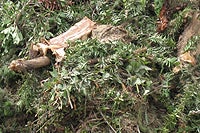
Green Trimmings

Grinder
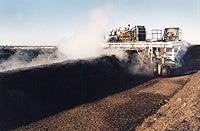
Windrow Turner
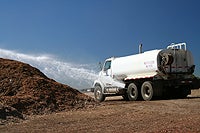
Recycled Water
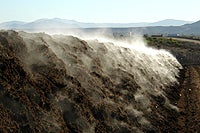
Heated to 165°F
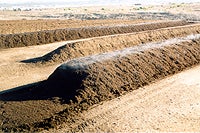
Windrows
Practical Application and Benefits of Mulch
Agricultural Use: Mulch can significantly reduce agricultural water costs. Research also shows that mulch can reduce the incidence of phytopthera (root-rot fungus) on avocado and citrus trees grown in infected soils. Spread the mulch around the base of plants and trees, taking care to keep the mulch from touching the stem or trunk. Spread mulch to a depth of 6-12 inches, at least out to the dripline of the plant.
Dust Control: Mulch applied over the surfaces of dirt roads and trails, or unvegetated open areas can reduce the incidence of dust clouds. Spread a layer of mulch 2-3 inches deep over the surface of dirt roads or trails.
Erosion Prevention: Mulch reduces soil erosion by lessening the impact of heavy rainfall on steep slopes and by increasing the water-holding capacity of the soil. Tests conducted at the SDSU Soil Erosion Laboratory in 2002 indicated that Miramar Greenery mulch, applied to a depth of four inches, completely protected a 2:1 slope from erosion during a 10-year rain event and reduced runoff by 50%.
Landscape Top Dressing: Mulch can be used as decorative top dressing to cover areas of bare soil between newly planted or established landscaping. Covering these areas with mulch can help reduce soil erosion, conserve water and suppress weed growth. Use the mulch around the base of plants and trees, taking care to keep the mulch from touching the stem or trunk. Spread mulch to a depth of 4-6 inches, at least out to the drip line of the plant.
Water Conservation: Using mulch as a ground cover over bare soil and around plants helps reduce water evaporation and the need for frequent irrigation.
Weed Suppression: Mulch application on bare soil or as a landscape top dressing hinders weed seed germination by blocking sunlight from reaching the soil surface. If weeds do germinate, they root in the mulch, making physical control easy.

